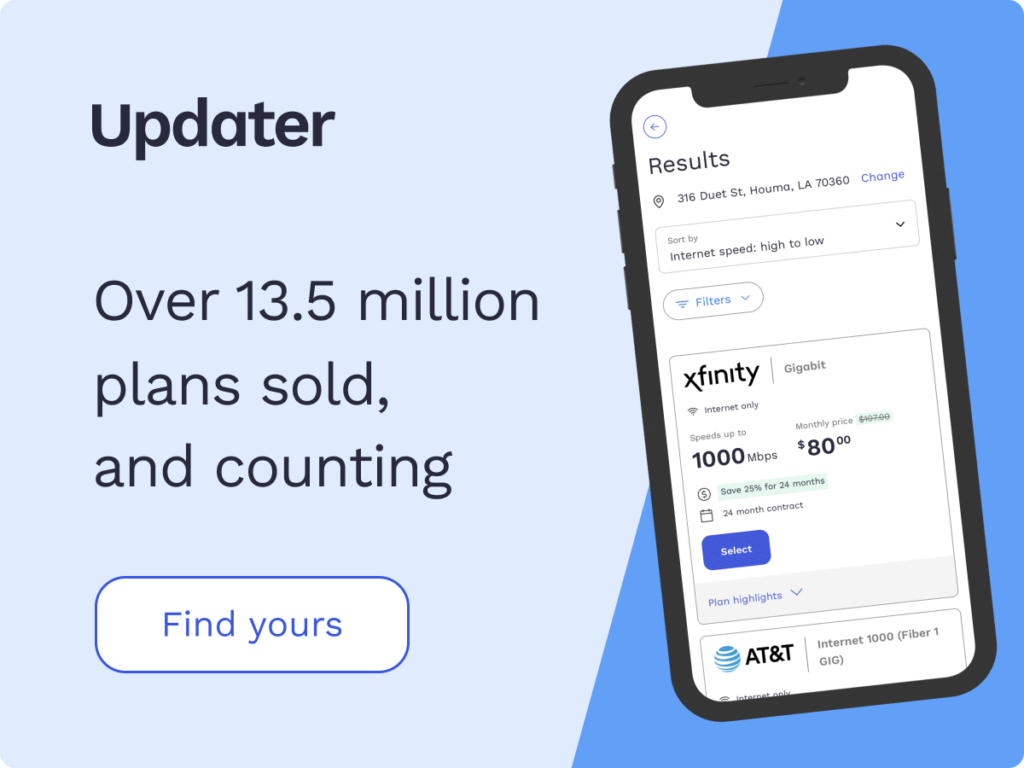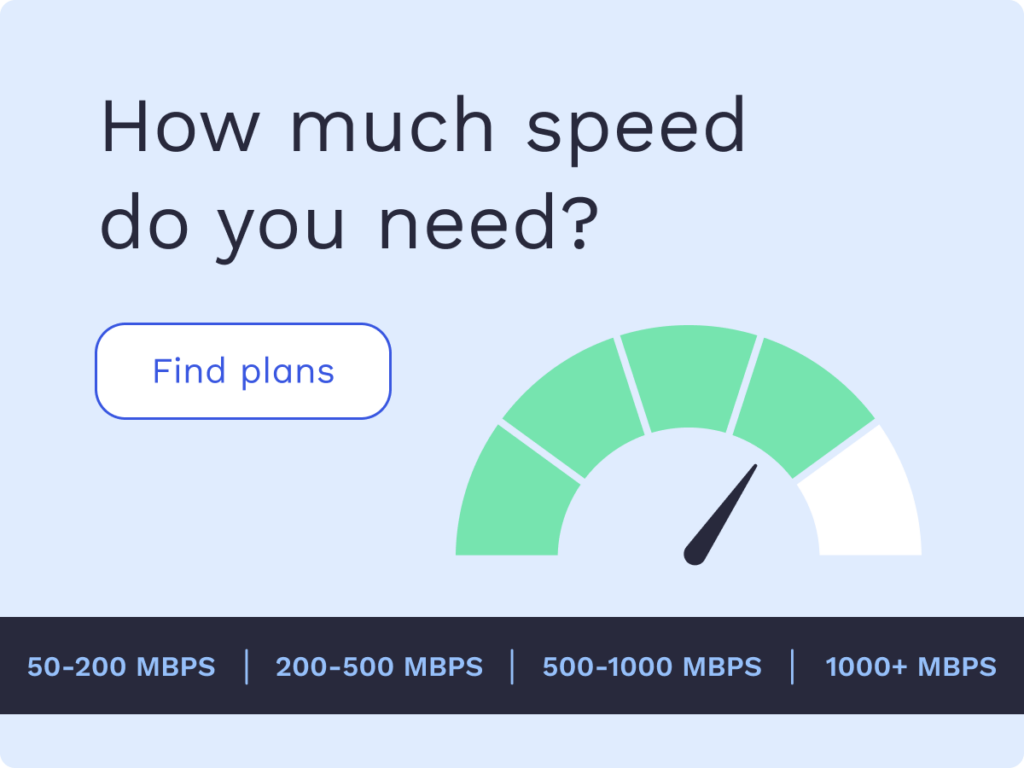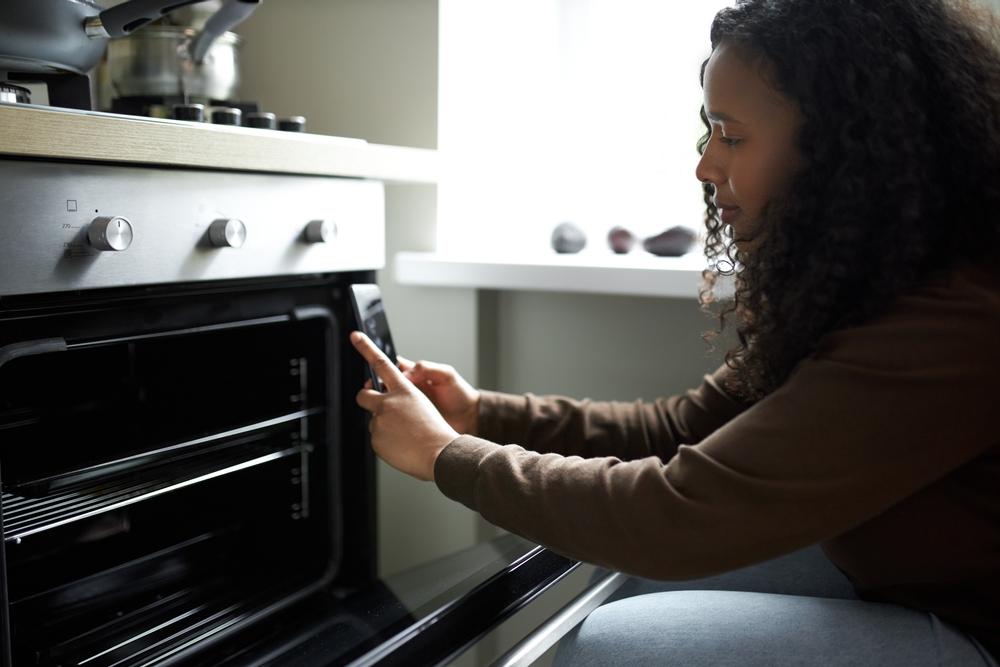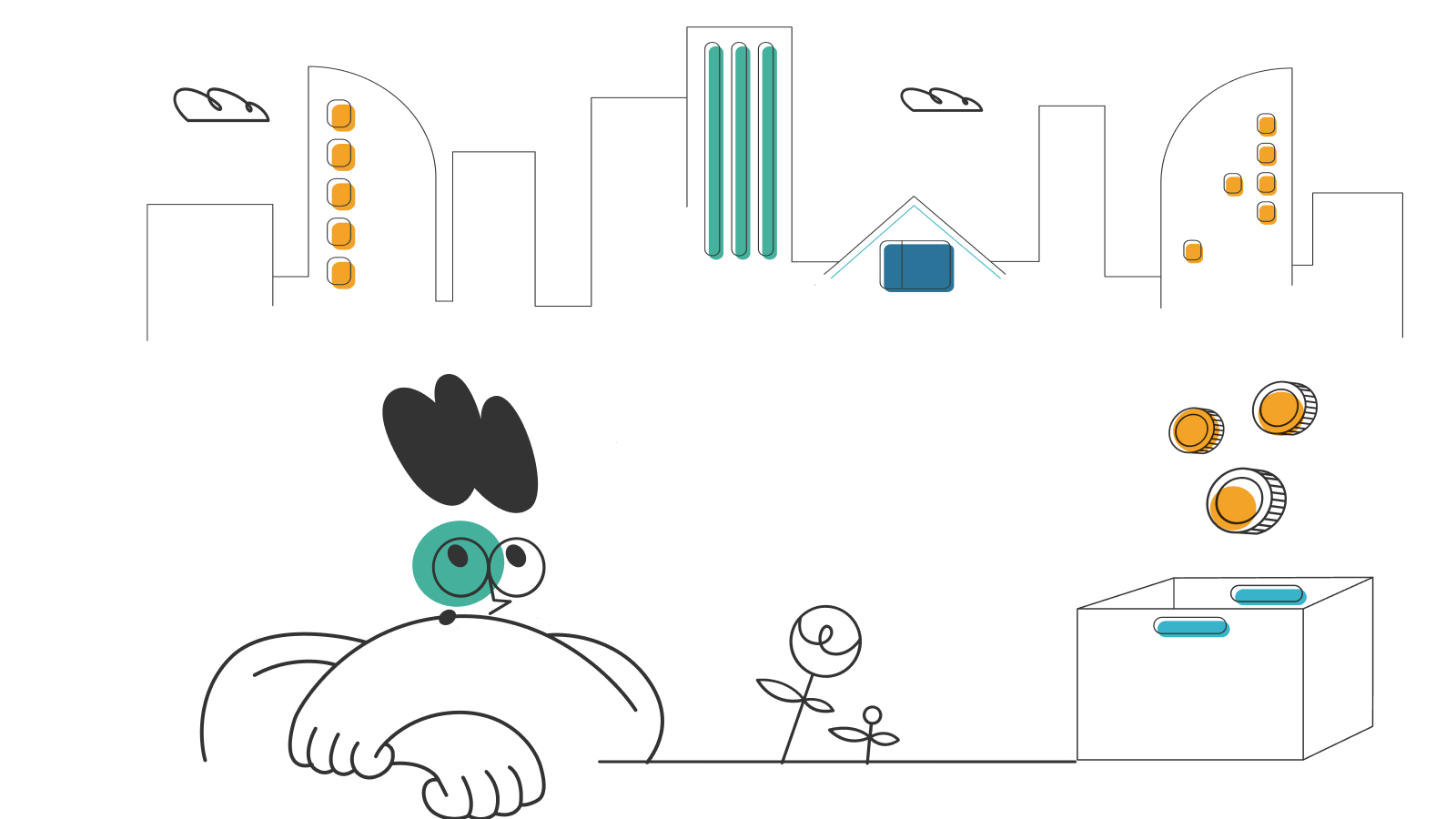How Much Internet Speed Do You Need?

As the number of connected devices in our homes continues to increase, high-speed internet access is becoming a necessity. From our phones to our computers, smart TVs to smart home devices, the internet is the driving force that keeps our day-to-day activities going. But every time someone yells from the other room about their online game lagging, the show you’re watching starts buffering at a pivotal moment, or an important video call drops, you may wonder if you need to upgrade to a higher speed plan. This is a common concern among many households these days.
If you’re thinking about upgrading your current internet plan or are just curious if what you’ve already signed up for should be enough, we’re here to help. We’ve gathered all the details you need to know about the anatomy of internet speed, guidelines on how to calculate your household’s speed needs, and a few tips to help you troubleshoot your current plan if it’s not performing at its best.
- What does “internet speed” mean?
- Are bandwidth and speed the same?
- What is the difference between download and upload speed?
- How much speed do you need?
- Is 1 Gig internet worth the cost?
- Do I need to change internet plans?
- Do I need to change internet providers?
What does “internet speed” mean?
Internet speed is a calculation of the number of bits (of data) per second that travels from the internet to a connected device (download), or from a connected device to the internet (upload). Though at the moment, speeds of 100Mbps or higher are generally considered “high-speed,” what we consider fast for internet speeds has changed a lot in recent years.
For instance, in the late 1990s, internet speeds were referred to in terms of kilobits per second (Kbps), and 56Kbps was considered “lighting fast.” People who remember this era of the internet will be telling their grandkids one day that when they were younger, it took 15 minutes to send one photo on the internet (and it will be a true story, too!)
These days, we generally refer to internet speeds in terms of megabits per second (Mbps). However, gigabit per second (Gbps) or Gig speeds are becoming more common, and companies like Google Fiber and AT&T have speed options up to 2Gbps and 5Gbps, respectively. There are also rumors that when 6G internet becomes a reality in the next 10-15 years, internet speeds could be as fast as 1 terabit per second (Tbps). It’s hard to imagine, isn’t it?
Are bandwidth and speed the same?
Although the terms “bandwidth” and “speed” are often thought of as one and the same, there is a difference between them. Both are measured in Mbps, but when a company advertises a plan of 100Mbps, they are actually referencing total bandwidth, not total speed.
Bandwidth is the amount of information that can be transferred per second, while speed is the literal speed at which the information moves. (Actual speed is related more to latency – or delay – than bandwidth.) Homes that have multiple connected devices performing online activities at once require more bandwidth to avoid delays, which is why we associate higher Mbps plans with higher speeds.
What is the difference between download and upload speed?
Internet service providers (ISPs) advertise their speed plans according to download speeds, although upload speeds are important too. In general, your plan will have a much faster download speed when compared with the upload speed.
Download speed
Download refers to how quickly you receive information. For instance, receiving text messages or pictures, watching a show or movie, and online gaming are all activities that rely on your plan’s download speed capabilities.
Upload speed
Upload refers to how quickly you send information from a device to the internet. Activities such as uploading files to YouTube, sending files through email, and videoconferencing all rely on your plan’s upload speed capabilities.
How much speed do you need?
Now that you have a better understanding of what internet plan speeds mean, how do you know which one is the best fit for you? There’s no doubt this can be a tricky question. While experts used to advise that each home have a certain amount of bandwidth per person (like 25-50Mbps per person in the household), these days it’s a little bit more complicated than that.
Not only can one person be on multiple devices at once (like watching a movie, while answering emails on their laptop or scrolling through social media on their phone), but there are a number of devices in your home that might require bandwidth even if no one is using them (like smart home devices). For that reason, figuring out how much speed is right for your home is more about the number of connected devices and how much bandwidth they are using at any given time.
Casual internet usage
Casual internet usage refers to everyday activities like surfing the web, checking emails, and scrolling through social media. These activities generally don’t require a lot of bandwidth. The following is a breakdown of recommended Mbps for each activity:
- Surfing the web: 5Mbps
- Checking email: 1Mbps
- Using social media: 10Mbps
- Streaming music: 1Mbps
Working from home
If you’re working from home, you’re likely sending and receiving files through email, joining video calls, and printing to a wireless printer as part of your day-to-day duties. The following list includes the recommended bandwidth for each work-related activity:
- Sending large files via email: 5Mbps
- Receiving large files via email: 10Mbps
- Video conferencing with one person: 5Mbps
- Video conferencing with multiple people: 10Mbps
- Wireless printing: 11Mbps
Streaming movies
For online video and movie lovers, you might be interested in knowing the recommended bandwidth for what you’re streaming:
- Streaming SD video: 5Mbps
- Streaming HD video: 10Mbps
- Streaming 4K video: 35Mbps
- Watching YouTube: 4Mbps
Online gaming
Nothing is worse for a gamer than experiencing lag in the middle of an online gaming session. The following are the minimum speeds recommended for online gaming:
- Gaming on your computer: 20Mbps
- Gaming on a console: 20Mbps
Influencer activities
Many activities performed by influencers depend more on upload speed than download speed. The following are the recommended upload speeds for the best experience while you complete your influencer activities:
- Uploading to YouTube: 25Mbps
- Live streaming: 6Mbps
- Uploading images to social media: 5Mbps
Wireless/smart devices
Think laptops, smartphones, and gaming systems are the only things using your bandwidth? Think again. When you start to look around, you may find there are a lot more gadgets connected to your home Wi-Fi than you realize, including:
- Smart TVs
- Smart lights
- Smart plugs
- Video doorbells
- Wireless security cameras
- Child monitors
- Pet monitors
While one or two of these devices might not make a noticeable impact, as you use more and more Wi-Fi-connected devices in your home, you may find your network slowing down. This could be an indication that you need more speed.
How much speed does the average US household need?
Many ISPs currently offer plans from as low as 25Mbps all the way up to 1000Mbps, but how much speed does the average household need? US News and World Report recently explored this question. Their review noted that while homes with four connected devices would do well with as little as 25Mbps, most experts recommend an internet speed of at least 100Mbps, with 400Mbps being more than enough for a “vast majority” of households in the US.
Is 1 Gig internet worth the cost?
1 Gig internet certainly sounds wonderful. It also tends to come at a premium price and is faster than most homes need. So is it worth the cost? For the average household, probably not. 1 Gig speeds are best for large families, multi-family units with hefty internet usage, and businesses. Content creators who stream online gameplay frequently might also find a use for 1 Gig speeds. Otherwise, most homes will have more than enough speed with a plan between 100 and 400Mbps.
Do I need to change internet plans?
If you’re frustrated with your current internet speed and are considering either upgrading to a faster plan, there are a few steps you can take before making a switch.
Check if you’re getting what you’re paying for
The first step you’ll want to take before changing internet plans is to test your current internet speed. This will help you determine if your connection is performing as well as it should. To do this, you can conduct a speed test. Several free services are available to complete your speed test, including the speed tool from Measurement Lab, which will tell you your upload speed, download speed, and latency in less than a minute.
If, after running the speed test you find it is not performing at the speed of your contract, it’s time to troubleshoot.
Troubleshoot your connection
These three tips might help you get your internet speed in gear.
- Restart your modem – You know how when your work computer is acting up, you call IT for help, and they ask if you tried restarting it? The same thing can apply to your modem, too.
- First, unplug both the power and Ethernet cables from your modem.
- Next, wait 2-3 minutes for the modem to fully power off.
- Then, reconnect the power and Ethernet cables, and wait for the internet light to turn solid.
- Once connected, re-run the speed test and check the results.
- Relocate your router – You may not realize this, but the location of your router could be impacting the connection and speed for your connected devices. Things like furniture, large appliances, and TVs may interfere with your home internet. Ideally, make sure your router is placed at least 3 feet off the ground and as central to all of the connected devices in your home as possible. If you live in a two-story home, place the router a foot below the ceiling between the first and second floors and as central as possible to the connected devices on both floors.
- Update your router – It’s possible that your router is outdated and needs to be updated. Make sure the router is certified for Wi-Fi 5 (802.11ac) or Wi-Fi 6 (802.11ax). This information can most likely be found on the router’s back label.
Do I need to change internet providers?
If you’ve run a speed test and tried to troubleshoot your existing connection but still are not achieving the speeds you should be, or if your rates are as expected and you feel like you need more, you might be wondering if you should change internet providers.
If your internet is not performing as it should, you can try calling your ISP directly to discuss the issues. They may have some tricks they can try on their end or suggest some additional troubleshooting tips that you can try.
If you’ve determined that you need a higher speed plan, your current ISP may have a plan to suit your needs, so a quick phone call to them may solve your issue.
On the other hand, if you’ve got your eye on another ISP with faster speeds or better prices (and you’re not locked into a long-term contract), now might be the time to make a switch. However, ake sure you dig into the details to fully understand additional costs that may come with a new internet plan before making any final decisions. Things to look for include installation fees, equipment rental fees, data overage fees, and early termination costs.
*Pricing varies by location and availability. Speeds may vary. All prices subject to change; for current pricing and availability visit our internet service page. Prices as of 3/22/22.
Disclosure | Updater articles are based on our own data and research, independent from partner relationships. We are not compensated by partners for information and opinions presented here. Our Editorial Terms of Service can be found here.














